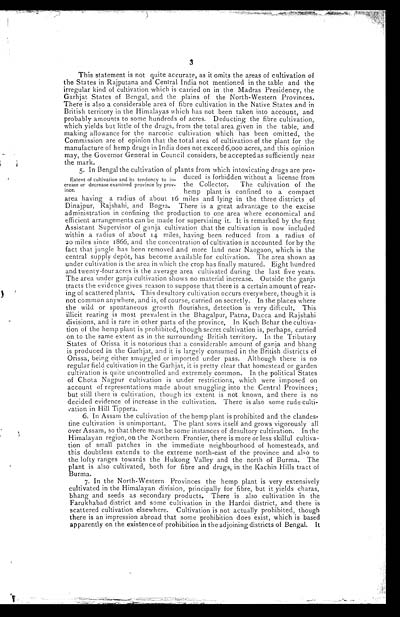Medicine - Drugs > Resolution. No. 1369 Ex. > Resolution. No. 1369 Ex.
(7) Page 3
Download files
Individual page:
Thumbnail gallery: Grid view | List view

3
This statement is not quite accurate, as it omits the areas of cultivation of
the States in Rajputana and Central India not mentioned in the table and the
irregular kind of cultivation which is carried on in the Madras Presidency, the
Garhjat States of Bengal, and the plains of the North-Western Provinces.
There is also a considerable area of fibre cultivation in the Native States and in
British territory in the Himalayas which has not been taken into account, and
probably amounts to some hundreds of acres. Deducting the fibre cultivation,
which yields but little of the drugs, from the total area given in the table, and
making allowance for the narcotic cultivation which has been omitted, the
Commission are of opinion that the total area of cultivation of the plant for the
manufacture of hemp drugs in India does not exceed 6,000 acres, and this opinion
may, the Governor General in Council considers, be accepted as sufficiently near
the mark.
Extent of cultivation and its tendency to in-
crease or decrease examined province by prov-
ince.
5. In Bengal the cultivation of plants from which intoxicating drugs are pro-
duced is forbidden without a license from
the Collector. The cultivation of the
hemp plant is confined to a compact
area having a radius of about 16 miles and lying in the three districts of
Dinajpur, Rajshahi, and Bogra. There is a great advantage to the excise
administration in confining the production to one area where economical and
efficient arrangements can be made for supervising it. It is remarked by the first
Assistant Supervisor of ganja cultivation that the cultivation is now included
within a radius of about 14 miles, having been reduced from a radius of
20 miles since 1866, and the concentration of cultivation is accounted for by the
fact that jungle has been removed and more land near Naogaon, which is the
central supply depôt, has become available for cultivation. The area shown as
under cultivation is the area in which the crop has finally matured. Eight hundred
and twenty-four acres is the average area cultivated during the last five years.
The area under ganja cultivation shows no material increase. Outside the ganja
tracts the evidence gives reason to suppose that there is a certain amount of rear-
ing of scattered plants. This desultory cultivation occurs everywhere, though it is
not common anywhere, and is, of course, carried on secretly. In the places where
the wild or spontaneous growth flourishes, detection is very difficult. This
illicit rearing is most prevalent in the Bhagalpur, Patna, Dacca and Rajshahi
divisions, and is rare in other parts of the province. In Kuch Behar the cultiva-
tion of the hemp plant is prohibited, though secret cultivation is, perhaps, carried
on to the same extent as in the surrounding British territory. In the Tributary
States of Orissa it is notorious that a considerable amount of ganja and bhang
is produced in the Garhjat, and it is largely consumed in the British districts of
Orissa, being either smuggled or imported under pass. Although there is no
regular field cultivation in the Garhjat, it is pretty clear that homestead or garden
cultivation is quite uncontrolled and extremely common. In the political States
of Chota Nagpur cultivation is under restrictions, which were imposed on
account of representations made about smuggling into the Central Provinces;
but still there is cultivation, though its extent is not known, and there is no
decided evidence of increase in the cultivation. There is also some rude culti-
vation in Hill Tippera.
6. In Assam the cultivation of the hemp plant is prohibited and the clandes-
tine cultivation is unimportant. The plant sows itself and grows vigorously all
over Assam, so that there must be some instances of desultory cultivation. In the
Himalayan region, on the Northem Frontier, there is more or less skilful cultiva-
tion of small patches in the immediate neighbourhood of homesteads, and
this doubtless extends to the extreme north-east of the province and also to
the lofty ranges towards the Hukong Valley and the north of Burma. The
plant is also cultivated, both for fibre and drugs, in the Kachin Hills tract of
Burma.
7. In the North-Western Provinces the hemp plant is very extensively
cultivated in the Himalayan division, principally for fibre, but it yields charas,
bhang and seeds as secondary products. There is also cultivation in the
Farukhabad district and some cultivation in the Hardoi district, and there is
scattered cultivation elsewhere. Cultivation is not actually prohibited, though
there is an impression abroad that some prohibition does exist, which is based
apparently on the existence of prohibition in the adjoining districts of Bengal. It
Set display mode to: Large image | Zoom image | Transcription
Images and transcriptions on this page, including medium image downloads, may be used under the Creative Commons Attribution 4.0 International Licence unless otherwise stated. ![]()
| India Papers > Medicine - Drugs > Resolution. No. 1369 Ex. > Resolution. No. 1369 Ex. > (7) Page 3 |
|---|
| Permanent URL | https://digital.nls.uk/74934037 |
|---|




